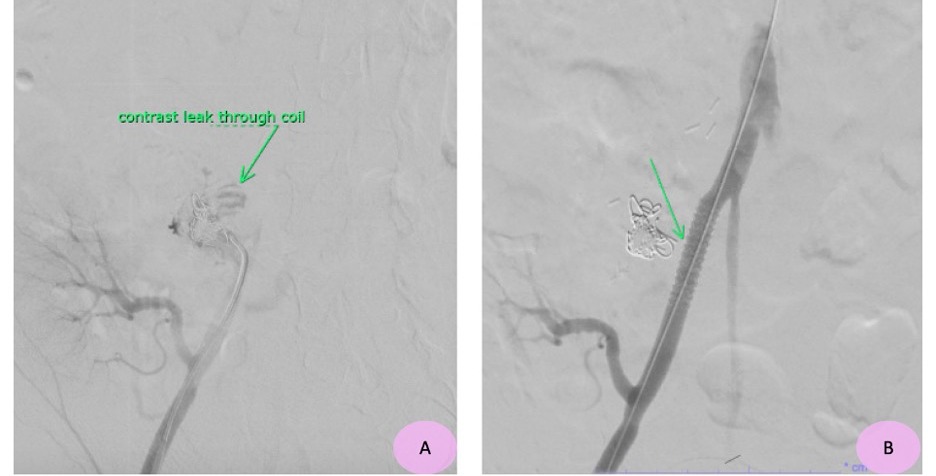Back
Poster Session D - Tuesday Morning
D0059 - A Rare Cause of Delayed Life-Threatening Hemorrhage in a Patient With Pancreas Transplant
Tuesday, October 25, 2022
10:00 AM – 12:00 PM ET
Location: Crown Ballroom

Michelle Baliss, DO
Saint Louis University
St. Louis, MO
Presenting Author(s)
Michelle Baliss, DO, Samuel Burton, MD, Emily Worrall, MD, Tim Brotherton, MD, Soumojit Ghosh, MD, Zarir Ahmed, DO, Laith Numan, MD, Kamran Qureshi, MD
Saint Louis University, St. Louis, MO
Introduction: Complications of vascular anastomosis usually occur early after pancreas transplant (PTx) and carry a substantial risk of graft loss and mortality. Hemorrhage may result from arterial anastomosis failure, but more commonly from superior mesenteric or splenic vessel ligation. We present a challenging case of GI hemorrhage from a pseudoaneurysm (PA) in the implanted vascular Y graft 7 years after PTx.
Case Description/Methods: A 45-year-old male 7 years post simultaneous pancreas-kidney transplant presented with painless rectal bleeding. EGD and Colonoscopy showed blood throughout the duodenum and colon, but the source could not be localized. Push enteroscopy showed blood extending into the proximal jejunum, and no active bleeding source could be identified. CT angiogram showed active extravasation into a small bowel loop near the PTx. Mesenteric angiography with IR revealed active extravasation into jejunum from a PA which had developed off the SMA Y graft anastomosis, eroding into the adjacent duodenal stump. Successful coil embolization was performed. 2 days later, he developed rectal bleeding requiring massive transfusion. Tagged RBC scan and CT angiography could not localize the bleeding source. Emergent mesenteric angiography showed contrast leakage into the anastomotic stump beyond the previously placed coil (Fig 1A). A covered stent was placed into the right external iliac artery arresting the bleeding into the SMA anastomotic stump (Fig 1B). Bleeding and shock resolved, and he was discharged with transplant surgery follow-up.
Discussion: Pseudoaneurysms, AV fistulae, arterial dissection and stenosis represent rare vascular complications of PTx. PAs, if early, may be the result of surgical technique, infection, severe pancreatitis, or allograft biopsy. Arterial anastomotic PAs can be asymptomatic or present with symptoms signaling impending rupture such as abdominal pain, pulsatile mass, or endocrine failure. Endoscopic localization and management of bleeding from Y graft PAs are challenging due to altered anatomy and brisk bleeding. Multidisciplinary management is essential and often involves endovascular hemostasis with IR, possibly with surgical exploration. Stent placement is usually preferred over embolization due to the ability to deploy with precision while maintaining end-organ perfusion. Although guidelines are lacking, it would be reasonable to consider periodic Doppler US to screen for post-operative PAs for early detection and preventative endovascular treatment.

Disclosures:
Michelle Baliss, DO, Samuel Burton, MD, Emily Worrall, MD, Tim Brotherton, MD, Soumojit Ghosh, MD, Zarir Ahmed, DO, Laith Numan, MD, Kamran Qureshi, MD. D0059 - A Rare Cause of Delayed Life-Threatening Hemorrhage in a Patient With Pancreas Transplant, ACG 2022 Annual Scientific Meeting Abstracts. Charlotte, NC: American College of Gastroenterology.
Saint Louis University, St. Louis, MO
Introduction: Complications of vascular anastomosis usually occur early after pancreas transplant (PTx) and carry a substantial risk of graft loss and mortality. Hemorrhage may result from arterial anastomosis failure, but more commonly from superior mesenteric or splenic vessel ligation. We present a challenging case of GI hemorrhage from a pseudoaneurysm (PA) in the implanted vascular Y graft 7 years after PTx.
Case Description/Methods: A 45-year-old male 7 years post simultaneous pancreas-kidney transplant presented with painless rectal bleeding. EGD and Colonoscopy showed blood throughout the duodenum and colon, but the source could not be localized. Push enteroscopy showed blood extending into the proximal jejunum, and no active bleeding source could be identified. CT angiogram showed active extravasation into a small bowel loop near the PTx. Mesenteric angiography with IR revealed active extravasation into jejunum from a PA which had developed off the SMA Y graft anastomosis, eroding into the adjacent duodenal stump. Successful coil embolization was performed. 2 days later, he developed rectal bleeding requiring massive transfusion. Tagged RBC scan and CT angiography could not localize the bleeding source. Emergent mesenteric angiography showed contrast leakage into the anastomotic stump beyond the previously placed coil (Fig 1A). A covered stent was placed into the right external iliac artery arresting the bleeding into the SMA anastomotic stump (Fig 1B). Bleeding and shock resolved, and he was discharged with transplant surgery follow-up.
Discussion: Pseudoaneurysms, AV fistulae, arterial dissection and stenosis represent rare vascular complications of PTx. PAs, if early, may be the result of surgical technique, infection, severe pancreatitis, or allograft biopsy. Arterial anastomotic PAs can be asymptomatic or present with symptoms signaling impending rupture such as abdominal pain, pulsatile mass, or endocrine failure. Endoscopic localization and management of bleeding from Y graft PAs are challenging due to altered anatomy and brisk bleeding. Multidisciplinary management is essential and often involves endovascular hemostasis with IR, possibly with surgical exploration. Stent placement is usually preferred over embolization due to the ability to deploy with precision while maintaining end-organ perfusion. Although guidelines are lacking, it would be reasonable to consider periodic Doppler US to screen for post-operative PAs for early detection and preventative endovascular treatment.

Figure: Fig 1: A. Pre-stent mesenteric angiogram with contrast leaking through coil into SMA anastomotic stump; B. Post stent mesenteric angiogram with no contrast leaking into the SMA anastomotic stump.
Disclosures:
Michelle Baliss indicated no relevant financial relationships.
Samuel Burton indicated no relevant financial relationships.
Emily Worrall indicated no relevant financial relationships.
Tim Brotherton indicated no relevant financial relationships.
Soumojit Ghosh indicated no relevant financial relationships.
Zarir Ahmed indicated no relevant financial relationships.
Laith Numan indicated no relevant financial relationships.
Kamran Qureshi: Salix Pharmaceutical – Consultant.
Michelle Baliss, DO, Samuel Burton, MD, Emily Worrall, MD, Tim Brotherton, MD, Soumojit Ghosh, MD, Zarir Ahmed, DO, Laith Numan, MD, Kamran Qureshi, MD. D0059 - A Rare Cause of Delayed Life-Threatening Hemorrhage in a Patient With Pancreas Transplant, ACG 2022 Annual Scientific Meeting Abstracts. Charlotte, NC: American College of Gastroenterology.
